The most numerous species of tiger!
Advertisement
Bengal Tiger Scientific Classification
- Kingdom
- Animalia
- Phylum
- Chordata
- Class
- Mammalia
- Order
- Carnivora
- Family
- Felidae
- Genus
- Panthera
- Scientific Name
- Panthera Tigris Tigris
Read our Complete Guide to Classification of Animals.
Bengal Tiger Conservation Status
Bengal Tiger Facts
- Main Prey
- Deer, Cattle, Wild Boar
- Habitat
- Dense tropical forest and mangroves
- Predators
- Human
- Diet
- Carnivore
- Average Litter Size
- 3
View all of the Bengal Tiger images!
Bengal tigers are the national animal of both Bangladesh and India.
One of the most beautiful and iconic animals to walk the Earth, Bengal tigers are both regal and rare. They’re one of the biggest cat species in the world. Bengals are larger than other tiger species, second only to the Siberian.

Today, wild Bengal tigers only live in Bangladesh, Bhutan, India, and Nepal. And while there are more Bengals than any other tiger subspecies on the Indian subcontinent, the populations are endangered.
Conservation efforts are working to some degree, but they’re not outpacing the poaching, deforestation, and human encroachment that has devastated wild tiger habitats over the past 50 years.
Fascinating Facts About Bengal Tigers
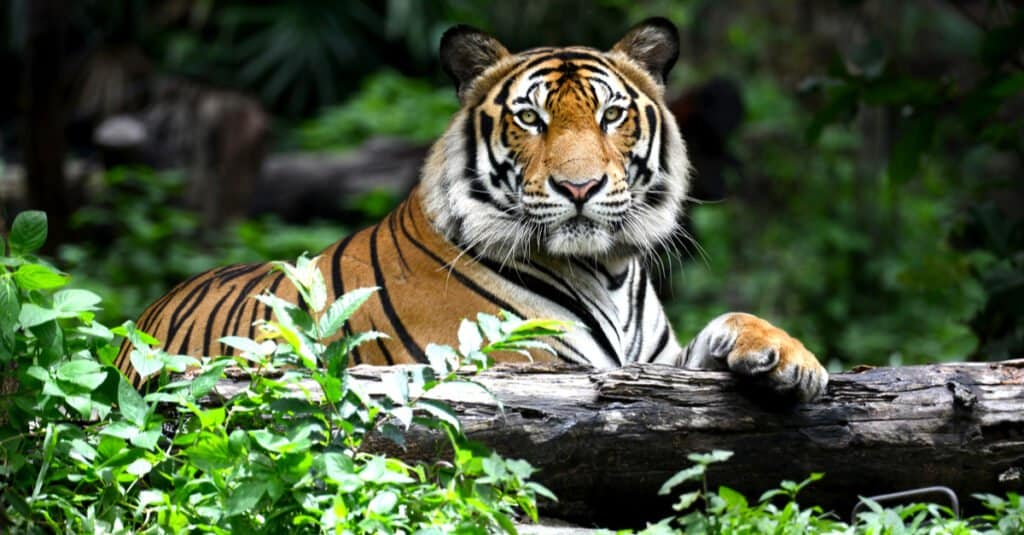
The Bengal tiger has been known to attack and kill humans.
©dangdumrong/Shutterstock.com
- Human residents of jungle villages that share space with large cats wear face masks on the back of their heads because tigers prefer to attack from behind. If the felines think a person is looking directly at them, they typically find another target.
- Between the late 1800s and early 1900s, a female Bengal tiger known as the ‘Champawat tiger’ killed 436 people around Nepal and Kumaun. After an autopsy, scientists realized her canine teeth were damaged, which prevented her from catching normal prey.
- It is believed that these tigers will coordinate attacks against larger prey like rhinoceros and elephants.
- Scientists believe Bengal tigers arrived in India between 12,000 to 15,000 years ago.
- In 2019, a Bengal tiger named Ming, a 19-year-old tiger that sadly spent most of his life living in a New York City apartment passed away. It was discovered that Ming’s human companion, Mr. Yates, fed him about 20 pounds of chicken meat a day and turned one room in the apartment into a sandpit for his “best friend.”
Scientific Name

Bengal tigers were once known as Royal Bengal tigers.
During the 19th century, these tigers were known as Royal Bengal tigers. Somewhere along the taxonomic line, however, the royal was dropped. Today, the animals are simply known as Bengal tigers, a population of the subspecies Panthera tigris tigris.
Panthera derives from the Lain word “panthēra” and the Greek word “pánthēr,” which both roughly translate to “that which is hunted.” The Sanskrit word “pând-ara,” meaning “pale yellow, whitish, white,” is also thought to play a role in how the animal got its name.
Evolution
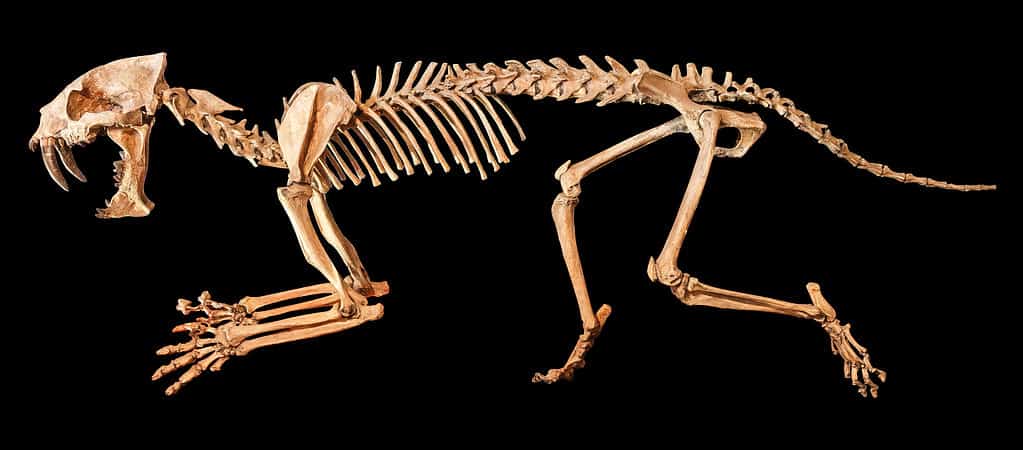
Sabertooth tigers were one of the early ancestors of Bengal tigers.
©Puwadol Jaturawutthichai/Shutterstock.com
The oldest ancestors to the tiger are Miacoids, among the first mammal carnivores. This group was divided into two groups called Feliformia and Caniformia around 40 million years ago. Feliformia was more cat-like and eventually evolved into cats, hyenas, civets, and mongooses.
Like other tigers, the Bengal evolved from ancient cats like the Smilodon, or sabertooth tiger that lived 35 million years ago. The family Felidae came into Asia ten million years ago, where it split into the genus, Panthera. The Bengal tiger adapted to its habitat to form its own species.
Appearance

Male Bengal tigers can weigh up to 569 pounds.
©iStock.com/Thinker360
Bengal tigers are one of the biggest subspecies of cats roaming the Earth today.
The majority of these tigers sport yellow to light orange coats with brown to black stripes, but their bellies and the inward-facing sides of their limbs are white.
How Big are Bengal Tigers?
Male tigers are typically between 9 to 10 feet long, including the tail, and about 3 to 3.5 feet tall from the ground. On average, male Bengals tip the scale between 397 and 569 pounds — which is about the same weight as a pig and half as heavy as a polar bear!
Females are slightly smaller than their male counterparts. They’re usually between 7.5 to 8.5 feet long, and while the same height as the males, only weigh about 220 to 350 pounds, about the same size as a reindeer.
Compared to other tiger species, Bengals are usually slightly larger.
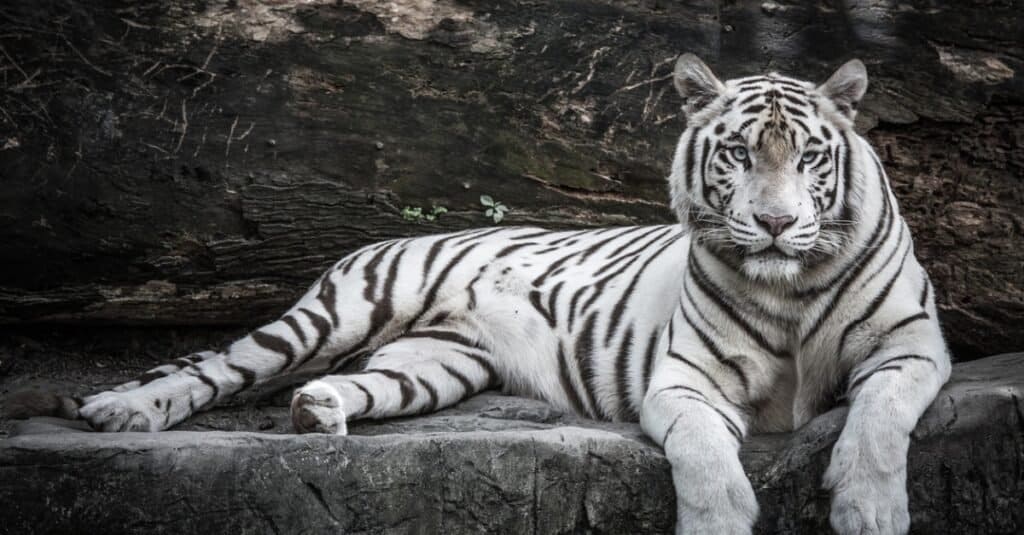
The
white tiger
is not a subspecies, but a product of a genetic mutation.
©w1snu.com/Shutterstock.com
What is a White Bengal Tiger?
Every so often, a Bengal tiger is born with an all-white coat with brown to black stripes. These “white Bengal tigers” tend to grow faster and larger than their yellow and orange peers.
What Was the Biggest Bengal Tiger Ever Recorded?
In November 1967, hunters in Uttar Pradesh, India, shot a Bengal tiger that was around 11 feet long. The behemoth tiger weighed a whopping 857 pounds. To date, that is the largest Bengal tiger ever recorded.
How Big are Bengal Tiger Teeth?
Bengal tigers have very large, sharp teeth. They fall between 3 and 3.9 inches from the gum line, making them the biggest canine teeth of all cat species.
Behavior
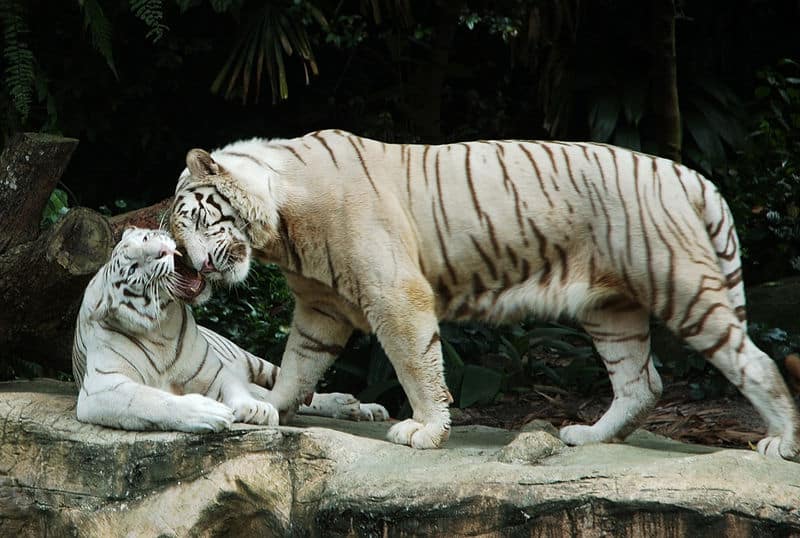
Bengal tigers are mostly solitary except for mother-cub groups.
©PlasticTV, CC BY-SA 3.0, via Wikimedia Commons – Original / License
The primary traveling unit of these tigers is a mother and her offspring. Besides the early-development period, which lasts about two to three years, Bengal tigers are solitary creatures. On rare occasions, a group of tigers will converge in the same area, usually because of a plentiful food source. When such gatherings happen, the group of tigers is called an ambush or streak.
These tigers, like nearly all other tiger species, have home territories that they rarely leave. When children go out on their own, females typically stick close to their mother’s area. During their first year living alone, adolescent cubs visit their mothers’ territories — females more often than males.
Habitat

Bengal tigers thrive in tropical forests and mangroves.
Generally speaking, Bengals live in tropical, subtropical, and temperate forests with access to water. Altitude-wise, they typically stay between 660 and 9,800 feet above sea level. However, that may be changing. In 2008, a Bengal tiger in Bhutan was caught on camera at 13,800 feet!
Today, these tigers live in India, Bangladesh, Nepal, and Bhutan. In India, they stick to tropical forests, subtropical deciduous forests, certain grasslands, and mangroves. Bangladesh has seen a thinning of the tiger population. The animals are now only found in the Sundarbans, which are mangrove forests, and the Chittagong Hill Tracts. Nepal is home to three small and isolated tiger populations in Chitwan National Park, Parsa National Park, and Bardiya National Park. In Bhutan, Bengals live in 17 of the country’s 18 districts.
Diet
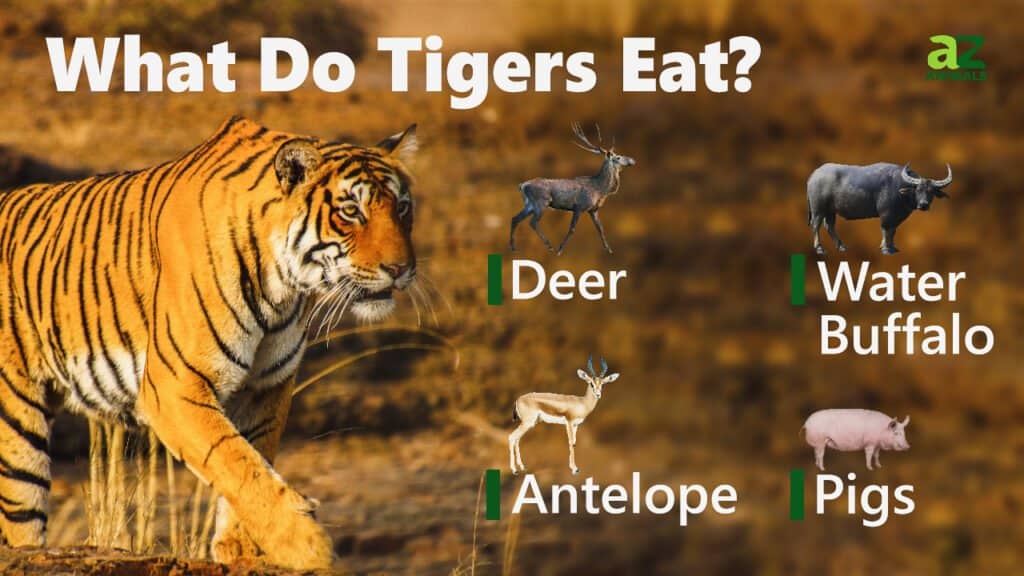
Bengal tigers, like all tigers, are carnivores. Their favorite meat comes from large, hooved mammals, including chital, gaur, and sambar. In a pinch, they’ll also prey on barasingha, water buffalo, nilgai, serow, takin, wild boar, hog deer, Indian muntjac, porcupines, hares, leopards, wolves, crocodiles, dhole, and peafowl. Increasing evidence also suggests that these tigers will coordinate attacks against rhinoceros and elephants.
Rural farmers must remain vigilant against Bengals because tigers also attack domesticated livestock. And though history is littered with stories of man-eating tigers, it’s a rare occurrence that typically only happens if the animal has a disability and can no longer catch other prey.
When making a kill, tigers approach from the back or side and immediately go for their victims’ throats. They then drag the carcass somewhere covered to eat.
In one sitting, tigers may consume up to 100 pounds of meat! But keep in mind that only one in 20 hunts is successful, and they only average one big meal a week.
Predators and Threats
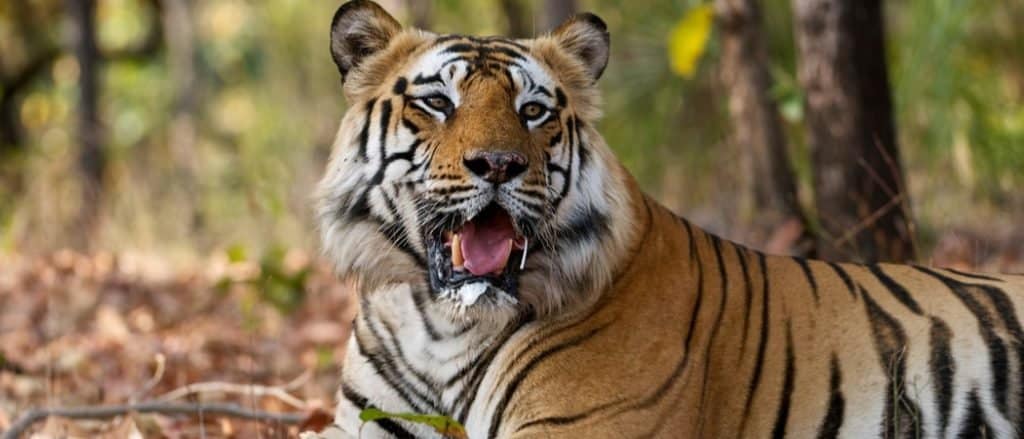
Poaching and habitat destruction have led to the Bengal tiger’s endangered status.
©Mary Angela Heys/Shutterstock.com
Poaching and habitat destruction, which cause population fragmentation, are the main threats to these tigers. Though lawmakers have implemented anti-poaching laws to protect big game, it remains a huge problem. A thriving and lucrative black market for skins and body parts — which pays a year’s salary for one kill — unfortunately encourages people to break the laws and hunt tigers.
Moreover, on account of India’s 2006 Forest Rights Act, more people are moving into jungle regions and encroaching on tiger territory. While the statute is a much-needed boon for indigenous human communities, it’s terrible for the subcontinent’s cat population.
The Indian government has established tiger Conservation Units, known as TCUs, in the foothills of the Himalayan Mountains. Encouragingly, populations appear to be rising in these areas. However, the International Union for the Conservation of Nature (IUCN) still lists these tigers as endangered. Much more work is still needed to ensure their survival in the wild.
Reproduction, Babies, and Lifespan

Young tiger cubs stay with their mothers for two or three years.
©Anuradha Marwah/Shutterstock.com
These tigers mate throughout the year, but many baby tigers are born in April and December. The pregnancy gestation period for female Bengals is about 3.5 months, and mothers usually have litters of up to six. Births happen in sheltered areas like tall grass, caves, and thick bush.
Baby tigers are called cubs and weigh between 1.7 and 3.5 pounds at birth. When they first come into the world, their eyes and ears are shut, and they’re covered in wooly fur that sheds between the ages of 3.5 and 5 months.
Like humans, Bengals’ first set of teeth isn’t permanent. They’re called “milk teeth” and are replaced with an adult set about 2.5 months after birth. Newborn tigers suckle their mothers for about three to six months and start trying solid foods at two months old.
Young tigers stay with their mother for about two to three years, and during that time, she doesn’t go into heat. But once her babies move away, she starts the reproductive cycle again. In other words, female Bengal tigers give birth every two to three years, depending on how many cubs they have per litter and how long their cubs stick with their mother.
In the wild, a Bengal tiger’s lifespan is approximately 15 years. The older they get, the weaker they get, and catching prey becomes more and more difficult. In captivity, Bengal tigers, barring disease and unforeseen accidents, usually live for 20 to 25 years.
Population

Bengal tiger populations are slowly improving.
©Muhammad Mahdi Karim, GFDL 1.2, via Wikimedia Commons – Original / License
How many Bengal tigers are thriving in the wild today? The Bengal tiger population is precarious though on the rise. In 2011, only about 2,500 lived in the wild. By 2018, that number had increased by a few hundred.
In 2010, the World Wildlife Fund for Nature launched the “Save Tigers Now” campaign, which works towards its stated goal of doubling the wild tiger population by 2022. They didn’t succeed – but numbers have increased to 3,500.
Private Big Cat Zoos Don’t Help the Tiger Population
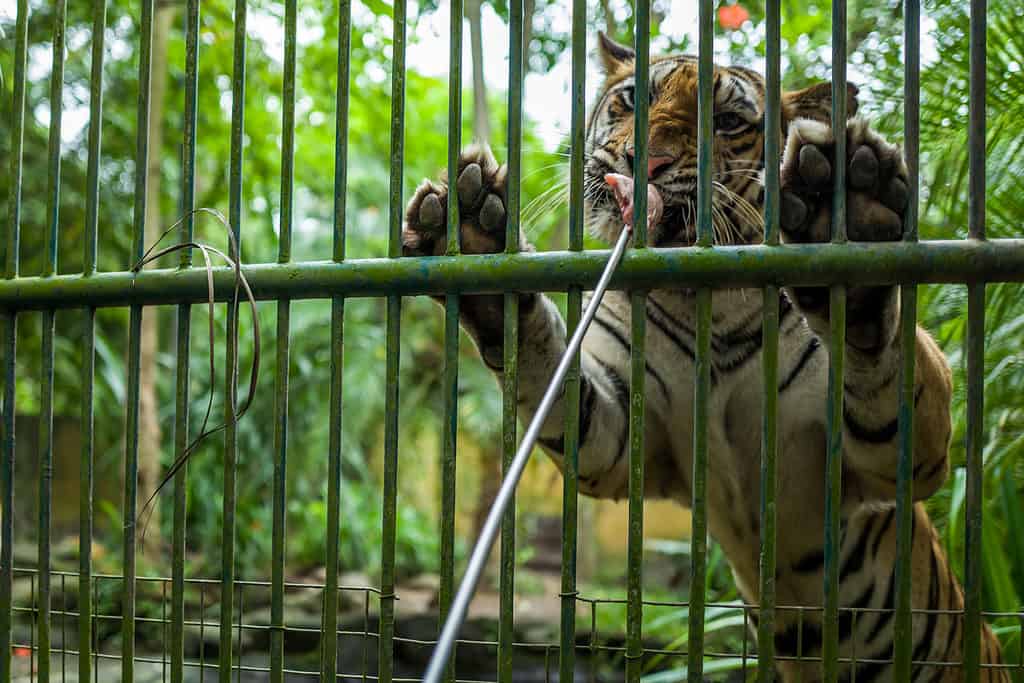
Tigers bred in captivity can not survive in the wild.
©Pierre Aden/Shutterstock.com
Unfortunately, over the past three decades, tiger breeding has become popular worldwide, especially in the United States. People open private zoos and breed tigers to exhibit. And while a patchwork of laws prevents some undesirable activity, the system isn’t foolproof.
What’s the problem with breeding tigers in captivity? For starters, the animals born in captivity are not genetically equipped to survive in the wild. Secondly, many of these tiger zoo keepers end up murdering animals when they get too large and can no longer participate in pet-a-tiger exhibits and shows.
Bengal Tiger FAQs (Frequently Asked Questions)
Are Bengal Tigers Carnivores, Herbivores, or Omnivores?
Wild tigers are carnivores, meaning they feed on meat. In an extreme pinch, you may catch a Bengal tiger chewing on grass and berries, but they cannot survive on vegetation alone.
Are Bengal Tigers Dangerous?
Though it’s rare for Bengal tigers to eat humans, it does happen, and people should remain vigilant when in or near tiger habitats. Villagers who live among tigers often wear face masks on the backs of their heads because cats, both large and small, rarely attack other animals head-on.
Where Do Bengal Tigers Live?
Bengal tigers live on the subcontinent in Bangladesh, Bhutan, India, and Nepal. They stick to forests and dense grasslands.
Why Is the Bengal Tiger Famous?
Bengal tigers are beloved the world over for their majestic appearance and strength. Humans have long admired their tenacity when stalking prey. Also, some people consider them to be a “royal” wild species.
How Much Does a Bengal Tiger Weigh?
Male Bengal tigers usually weigh between 397 and 569 pounds. Female Bengal tigers typically tip the scale between 220 to 350 pounds.
How Fast Is a Bengal Tiger?
Despite their enormous size, Bengal tigers can reach speeds between 35 to 40 miles per hour. However, they’re not marathon runners and can only sustain such speeds for a sprint.
Why Do Hunters Still Poach Bengal Tigers?
Unfortunately, traditional medicines, which many people still swear by, use tiger body parts. Additionally, tiger skins, furs, and teeth are desired items on the black market.
What Kingdom do Bengal Tigers belong to?
Bengal Tigers belong to the Kingdom Animalia.
What phylum do Bengal Tigers belong to?
Bengal Tigers belong to the phylum Chordata.
What class do Bengal Tigers belong to?
Bengal Tigers belong to the class Mammalia.
What family do Bengal Tigers belong to?
Bengal Tigers belong to the family Felidae.
What order do Bengal Tigers belong to?
Bengal Tigers belong to the order Carnivora.
What genus do Bengal Tigers belong to?
Bengal Tigers belong to the genus Panthera.
What type of covering do Bengal Tigers have?
Bengal Tigers are covered in Fur.
What is the main prey for Bengal Tigers?
Bengal Tigers prey on deer, cattle, and wild boar.
What are some predators of Bengal Tigers?
Predators of Bengal Tigers include humans.
What is the average litter size for a Bengal Tiger?
The average litter size for a Bengal Tiger is 3.
What is an interesting fact about Bengal Tigers?
Bengal Tigers are the most numerous species of tiger!
What is the scientific name for the Bengal Tiger?
The scientific name for the Bengal Tiger is Panthera Tigris Tigris.
What is the lifespan of a Bengal Tiger?
Bengal Tigers can live for 18 to 25 years.
What's the difference between Bengal tigers and Siberian tigers?
Siberian tigers differ from Bengal tigers in geographic location, habitat preferences, and size. Read more about those differences here.
How to say Bengal Tiger in ...
Thank you for reading! Have some feedback for us? Contact the AZ Animals editorial team.
Sources
- David Burnie, Dorling Kindersley (2011) Animal, The Definitive Visual Guide To The World's Wildlife / Accessed May 27, 2010
- Tom Jackson, Lorenz Books (2007) The World Encyclopedia Of Animals / Accessed May 27, 2010
- David Burnie, Kingfisher (2011) The Kingfisher Animal Encyclopedia / Accessed May 27, 2010
- Richard Mackay, University of California Press (2009) The Atlas Of Endangered Species / Accessed May 27, 2010
- David Burnie, Dorling Kindersley (2008) Illustrated Encyclopedia Of Animals / Accessed May 27, 2010
- Dorling Kindersley (2006) Dorling Kindersley Encyclopedia Of Animals / Accessed May 27, 2010
- David W. Macdonald, Oxford University Press (2010) The Encyclopedia Of Mammals / Accessed May 27, 2010


















